Assessing Spanish proficiency in job candidates can be challenging but is essential for roles requiring strong communication skills in Spanish. Use our list of interview questions tailored specifically for evaluating Spanish language skills effectively.
This blog post provides questions and answers designed for various proficiency levels—from junior to top speakers. It also includes questions focusing on grammar, vocabulary, pronunciation, and cultural understanding.
Utilize these questions to ensure you hire candidates with the necessary Spanish skills. Complement your interviews with our Spanish Proficient C1 test to streamline the hiring process.
Table of contents
8 general Spanish Proficiency interview questions and answers
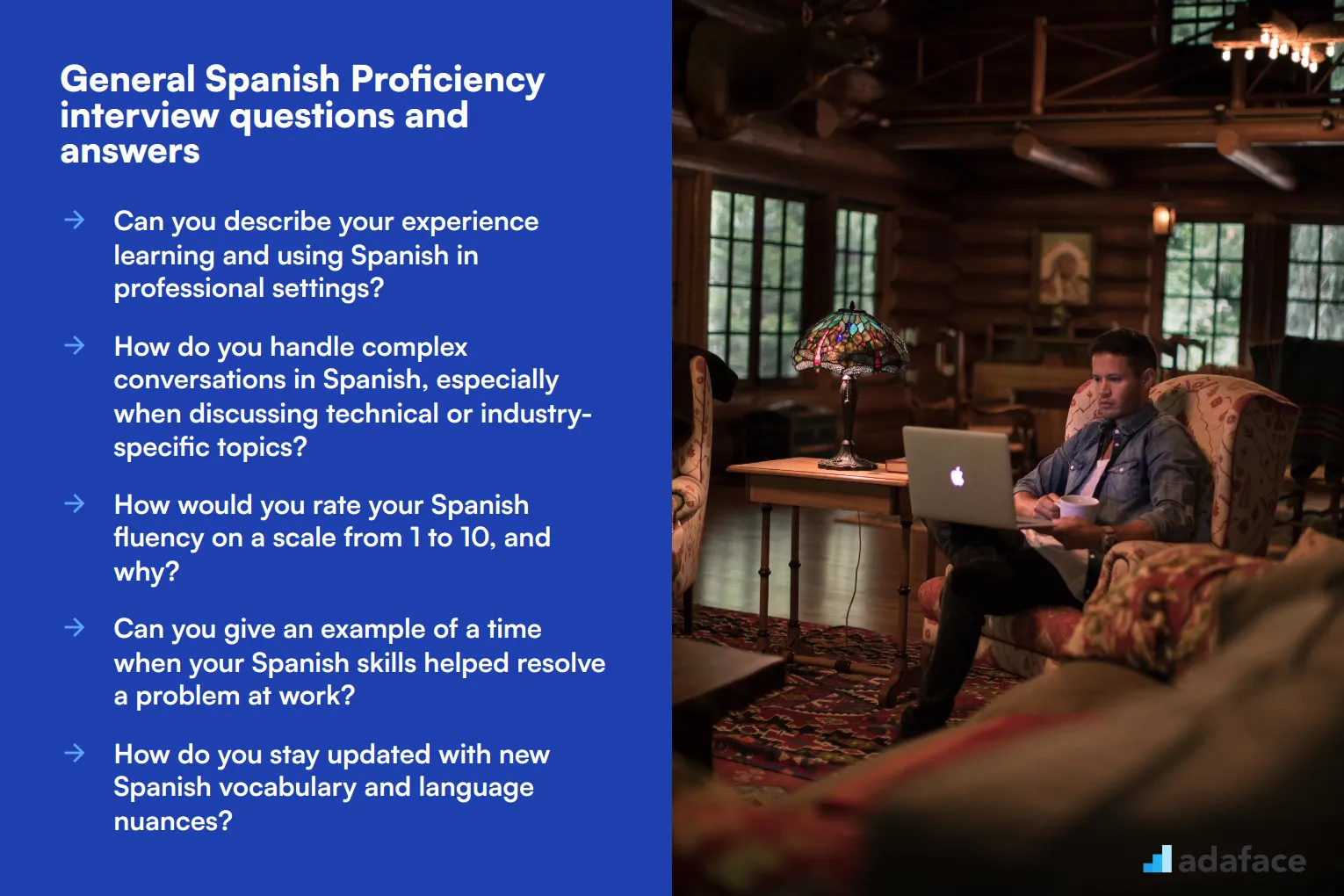
To gauge a candidate's proficiency in Spanish, use these general interview questions. They will help you determine their fluency, comprehension, and ability to communicate effectively in Spanish—essential for roles that require bilingual skills.
1. Can you describe your experience learning and using Spanish in professional settings?
I've studied Spanish for several years, starting from high school and continuing through college. In my last job, I frequently used Spanish to communicate with our clients from Latin America, ensuring that projects ran smoothly and meeting their specific needs.
An ideal candidate should demonstrate consistent use of Spanish in their professional life. Look for examples of how they've used Spanish to achieve business goals or improve customer relations.
2. How do you handle complex conversations in Spanish, especially when discussing technical or industry-specific topics?
When discussing complex topics, I ensure I understand the industry-specific terminology in Spanish. I often prepare by reading relevant materials in both languages and practicing with a native speaker if possible. This helps me to confidently navigate technical conversations.
Strong candidates should show an ability to prepare and adapt their language skills to handle industry-specific discussions. They should mention strategies like studying relevant vocabulary or practicing with peers.
3. How would you rate your Spanish fluency on a scale from 1 to 10, and why?
I would rate my fluency as an 8. I am comfortable with everyday conversations and professional communication, although I occasionally encounter challenges with highly specialized or idiomatic expressions.
The candidate's self-assessment should be realistic and provide insight into their strengths and areas for improvement. Follow up by asking for specific examples to validate their rating.
4. Can you give an example of a time when your Spanish skills helped resolve a problem at work?
In my previous role, we had a client who only spoke Spanish and had an issue with our service. I was able to communicate directly with them, understand their concerns, and work with the team to resolve the problem promptly, which helped maintain a positive client relationship.
Look for candidates who can provide concrete examples of using Spanish to solve real-world problems. This indicates practical application of their language skills in a professional setting.
5. How do you stay updated with new Spanish vocabulary and language nuances?
I stay updated by regularly reading Spanish-language news articles, watching Spanish films and series, and engaging in conversations with native speakers. Additionally, I use language learning apps to practice new vocabulary and nuances.
Candidates should demonstrate a proactive approach to maintaining and improving their language skills. Continuous learning and real-world practice are key indicators of their commitment to fluency.
6. How do you handle situations where you don't understand something said in Spanish?
If I don't understand something, I politely ask the speaker to repeat or rephrase their statement. I also make a note of unfamiliar terms to look up later. It's important to stay calm and courteous to ensure effective communication.
Effective communication skills include knowing how to handle misunderstandings gracefully. Look for candidates who emphasize patience, politeness, and a willingness to learn.
7. Can you translate a complex document or speech from English to Spanish (or vice versa)?
Yes, I have experience translating technical documents and speeches. When translating, I focus on maintaining the original meaning and tone while ensuring the translation is culturally appropriate and clear for the target audience.
The candidate should provide examples of past translation work and discuss their strategies for maintaining accuracy and context. This shows their practical translation skills and attention to detail.
8. Describe a time when you had to explain a difficult concept in Spanish to someone who was not fluent in the language.
In my previous role, I had to explain a complex project plan to a Spanish-speaking client who had limited technical knowledge. I used simple language and visual aids to ensure they understood the key points and felt confident in our approach.
Effective communication often involves simplifying complex information. Look for candidates who can break down intricate concepts and use tools or examples to aid understanding.
20 Spanish Proficiency interview questions to ask junior speakers
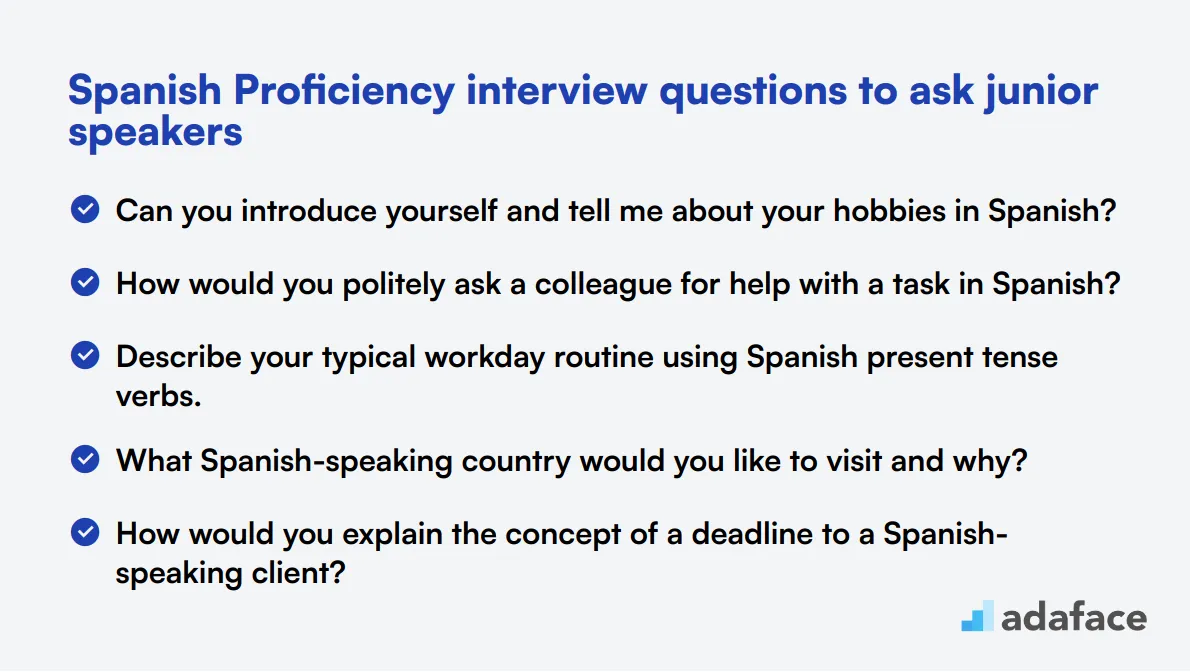
To assess the Spanish proficiency of junior speakers during interviews, use these 20 questions tailored for entry-level positions. These questions will help you evaluate basic language skills and cultural understanding, ensuring candidates can handle simple professional interactions in Spanish.
- Can you introduce yourself and tell me about your hobbies in Spanish?
- How would you politely ask a colleague for help with a task in Spanish?
- Describe your typical workday routine using Spanish present tense verbs.
- What Spanish-speaking country would you like to visit and why?
- How would you explain the concept of a deadline to a Spanish-speaking client?
- Can you name five office supplies in Spanish and use them in a sentence?
- How would you ask for clarification if you didn't understand a Spanish email?
- Describe the weather today and your ideal weather conditions in Spanish.
- How would you politely decline an invitation to lunch with colleagues in Spanish?
- Can you explain the difference between 'ser' and 'estar' with examples?
- How would you ask for directions to the nearest coffee shop in Spanish?
- Describe your favorite meal and how to prepare it in Spanish.
- How would you introduce a new team member to your Spanish-speaking colleagues?
- Can you explain the basic structure of a formal Spanish business letter?
- How would you handle a simple customer complaint in Spanish?
- Describe your ideal vacation using the Spanish future tense.
- How would you ask for a day off work in Spanish?
- Can you name five common Spanish idioms and explain their meanings?
- How would you conduct a basic phone conversation in Spanish?
- Describe a recent news event you've read about in Spanish.
10 intermediate Spanish Proficiency interview questions and answers to ask mid-tier speakers
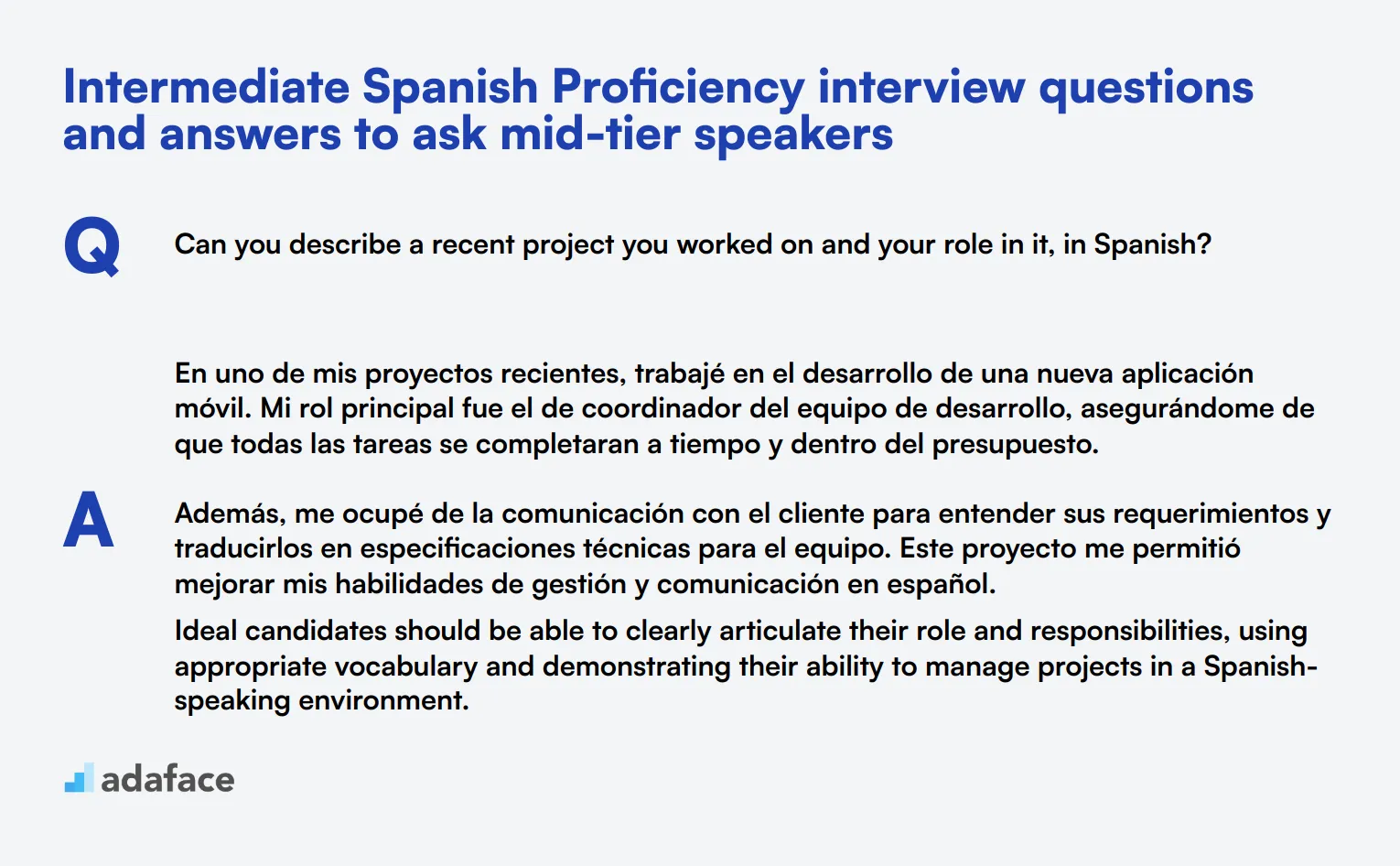
To assess the Spanish proficiency of mid-tier speakers effectively, consider using these interview questions. They are designed to evaluate the candidate's ability to communicate fluently and handle everyday work situations in Spanish.
1. Can you describe a recent project you worked on and your role in it, in Spanish?
En uno de mis proyectos recientes, trabajé en el desarrollo de una nueva aplicación móvil. Mi rol principal fue el de coordinador del equipo de desarrollo, asegurándome de que todas las tareas se completaran a tiempo y dentro del presupuesto.
Además, me ocupé de la comunicación con el cliente para entender sus requerimientos y traducirlos en especificaciones técnicas para el equipo. Este proyecto me permitió mejorar mis habilidades de gestión y comunicación en español.
Ideal candidates should be able to clearly articulate their role and responsibilities, using appropriate vocabulary and demonstrating their ability to manage projects in a Spanish-speaking environment.
2. How would you explain a complex technical issue to a non-technical Spanish-speaking colleague?
Para explicar un problema técnico complejo a un colega no técnico, primero intentaría simplificar el lenguaje técnico. Por ejemplo, si el problema es con el servidor, podría decir: 'El servidor es como un gran archivo de almacenamiento, y ahora mismo está lleno, lo que ralentiza todo.'
Usaría analogías y ejemplos cotidianos para que el colega pueda entender mejor la situación. También me aseguraría de repetir y verificar que han entendido al pedirles que me expliquen lo que han comprendido.
Look for candidates who can communicate complex ideas in a simple and clear manner, showing empathy and the ability to adjust their language for different audiences.
3. Can you describe a challenging interaction you had in Spanish and how you resolved it?
Una vez tuve una interacción desafiante con un cliente que no estaba satisfecho con un servicio. El cliente hablaba español y estaba muy frustrado. Primero, escuché sus preocupaciones sin interrumpir, y luego le aseguré que entendía su problema.
Le expliqué las posibles soluciones y lo mantuve informado durante todo el proceso de resolución. Finalmente, el cliente quedó satisfecho con el resultado y agradecido por la atención recibida.
Candidates should demonstrate their problem-solving skills and ability to handle stressful situations while maintaining professionalism and clear communication in Spanish.
4. How do you ensure clarity in written communications in Spanish, such as emails or reports?
Para asegurar la claridad en las comunicaciones escritas en español, siempre empiezo con un esquema claro y organizado de los puntos que quiero cubrir. Utilizo un lenguaje sencillo y directo, evitando jerga técnica innecesaria.
Reviso y edito mis escritos para corregir errores gramaticales y de puntuación. También leo en voz alta para asegurarme de que el mensaje sea claro y fluido. En algunas ocasiones, pido a un colega que revise el documento para obtener una segunda opinión.
Strong responses should reflect attention to detail, good command of written Spanish, and a clear process for ensuring high-quality communication.
5. How would you conduct a basic training session in Spanish for new team members?
Para conducir una sesión de entrenamiento básica en español, comenzaría con una introducción clara del tema y los objetivos del entrenamiento. Aseguraría que todos los materiales de apoyo, como presentaciones y manuales, estén disponibles en español.
Usaría ejemplos prácticos y sesiones interactivas para involucrar a los nuevos miembros del equipo. Al final, dejaría un espacio para preguntas y me aseguraría de que todos hayan entendido los puntos clave.
Candidates should show they can plan and execute a training session effectively, using clear and engaging methods to ensure comprehension and involvement.
6. How do you handle feedback and criticism in a Spanish-speaking work environment?
Manejo la retroalimentación y la crítica en un entorno laboral de habla hispana con una actitud abierta y receptiva. Escucho atentamente los comentarios y agradezco a quien los da, independientemente de si son positivos o negativos.
Analizo la crítica constructiva para identificar áreas de mejora y tomo medidas para corregir y aprender de los errores. Creo que la retroalimentación es esencial para el crecimiento profesional.
An ideal candidate should demonstrate maturity and professionalism, showing how they use feedback to improve their performance and maintain positive working relationships.
7. Can you tell me a story in Spanish about a memorable work experience?
Una experiencia laboral memorable fue cuando lideré un proyecto internacional. Trabajamos con un equipo en España y tuvimos que coordinar nuestras actividades en diferentes zonas horarias. Fue desafiante pero gratificante.
Utilicé mis habilidades en español para comunicarme de manera efectiva con el equipo internacional, asegurando que todos estuvieran alineados con los objetivos del proyecto y cumpliéramos con los plazos establecidos.
Candidates should be able to narrate a coherent and engaging story, showcasing their language proficiency and their ability to handle international or cross-cultural projects.
8. How would you write a follow-up email in Spanish after a meeting?
Después de una reunión, escribiría un correo de seguimiento en español resumiendo los puntos clave discutidos y las acciones acordadas. Por ejemplo: 'Estimado equipo, agradezco su participación en la reunión de hoy. A continuación, les detallo los puntos principales y las próximas acciones.'
Incluiría un resumen claro y conciso, fechas límite y responsables de cada tarea, asegurándome de que todos los destinatarios están en copia. Terminaría el correo con una nota de agradecimiento y disponibilidad para aclarar cualquier duda.
Look for clarity, organization, and professionalism in their response, ensuring they can provide concise summaries and clear action items to ensure team alignment.
9. How do you manage your workflow and prioritize tasks when working in a Spanish-speaking environment?
Para gestionar mi flujo de trabajo y priorizar tareas en un entorno de habla hispana, utilizo herramientas de gestión de proyectos como Trello o Asana. Establezco prioridades basándome en la urgencia y la importancia de cada tarea.
Comunico mis prioridades con el equipo para asegurar que todos estén alineados y utilizo listas diarias para mantenerme organizado. Me aseguro de revisar y ajustar mis prioridades según sea necesario.
Candidates should show their ability to use project management tools effectively and communicate their workflow clearly in Spanish, ensuring smooth team operations.
10. Can you describe how you would handle a disagreement with a Spanish-speaking colleague?
Para manejar un desacuerdo con un colega de habla hispana, primero me enfocaría en escuchar su perspectiva sin interrumpir. Luego, expresaría mis propios puntos de vista de manera calmada y respetuosa, buscando un terreno común.
Usaría frases como 'Entiendo tu punto, pero...' para mostrar empatía mientras presento mi argumento. Si es necesario, propondría una reunión con un mediador para resolver el conflicto de manera justa.
Look for candidates who can demonstrate empathy, good listening skills, and a collaborative approach to resolving conflicts in a respectful and professional manner.
12 Spanish Proficiency interview questions about grammar and vocabulary
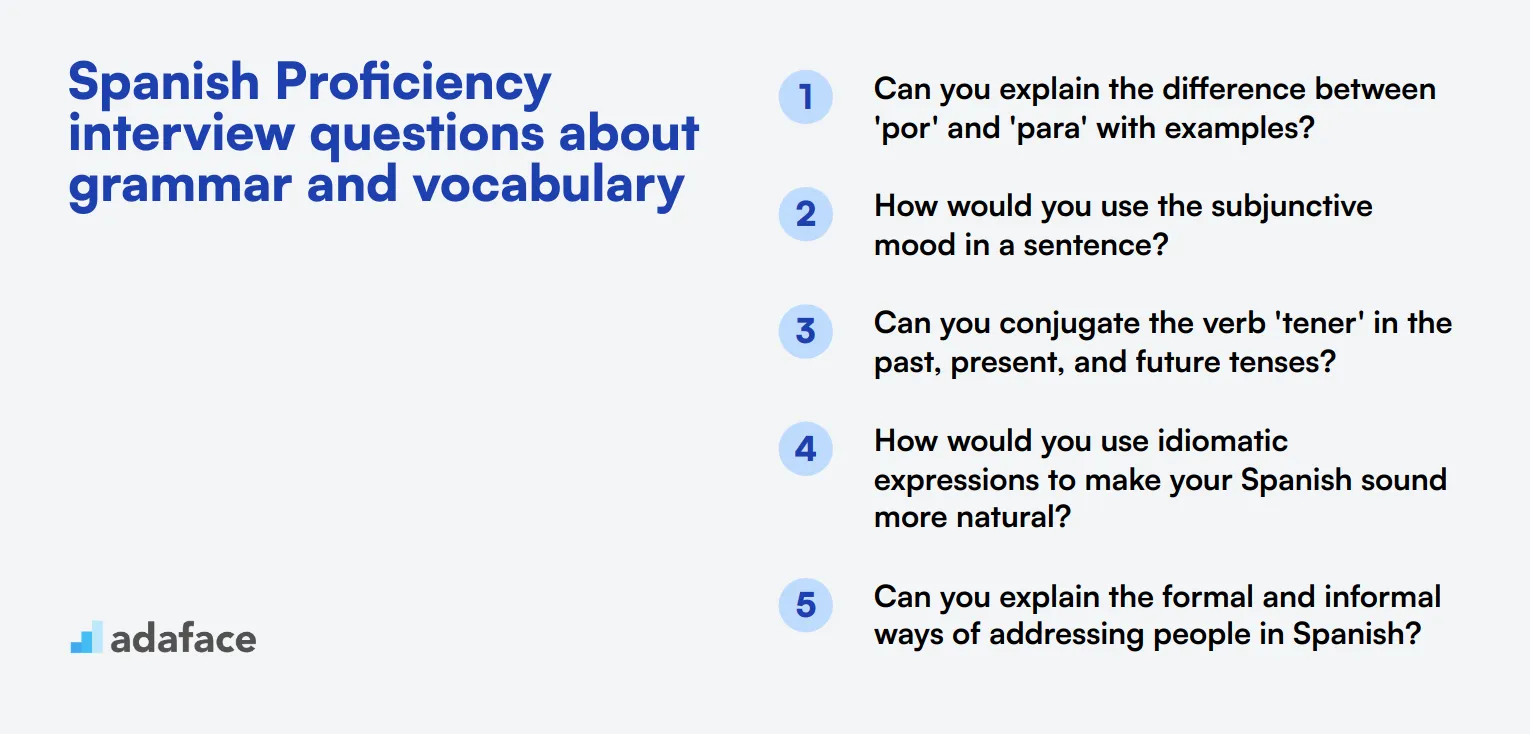
To determine whether applicants have a solid understanding of Spanish grammar and vocabulary, consider using these interview questions. They can help you assess candidates' language proficiency, ensuring they possess the necessary skills for roles that require effective communication in Spanish, such as a content writer.
- Can you explain the difference between 'por' and 'para' with examples?
- How would you use the subjunctive mood in a sentence?
- Can you conjugate the verb 'tener' in the past, present, and future tenses?
- How would you use idiomatic expressions to make your Spanish sound more natural?
- Can you explain the formal and informal ways of addressing people in Spanish?
- How do you differentiate between masculine and feminine nouns in Spanish?
- Can you describe the usage of direct and indirect object pronouns in Spanish?
- How would you form and use the imperfect tense in Spanish?
- Can you give examples of compound sentences in Spanish using conjunctions?
- How do you handle the placement of adjectives in Spanish sentences?
- Can you explain the rules for accentuation and stress in Spanish words?
- How would you use reflexive verbs in daily conversations?
7 Spanish Proficiency interview questions and answers related to pronunciation
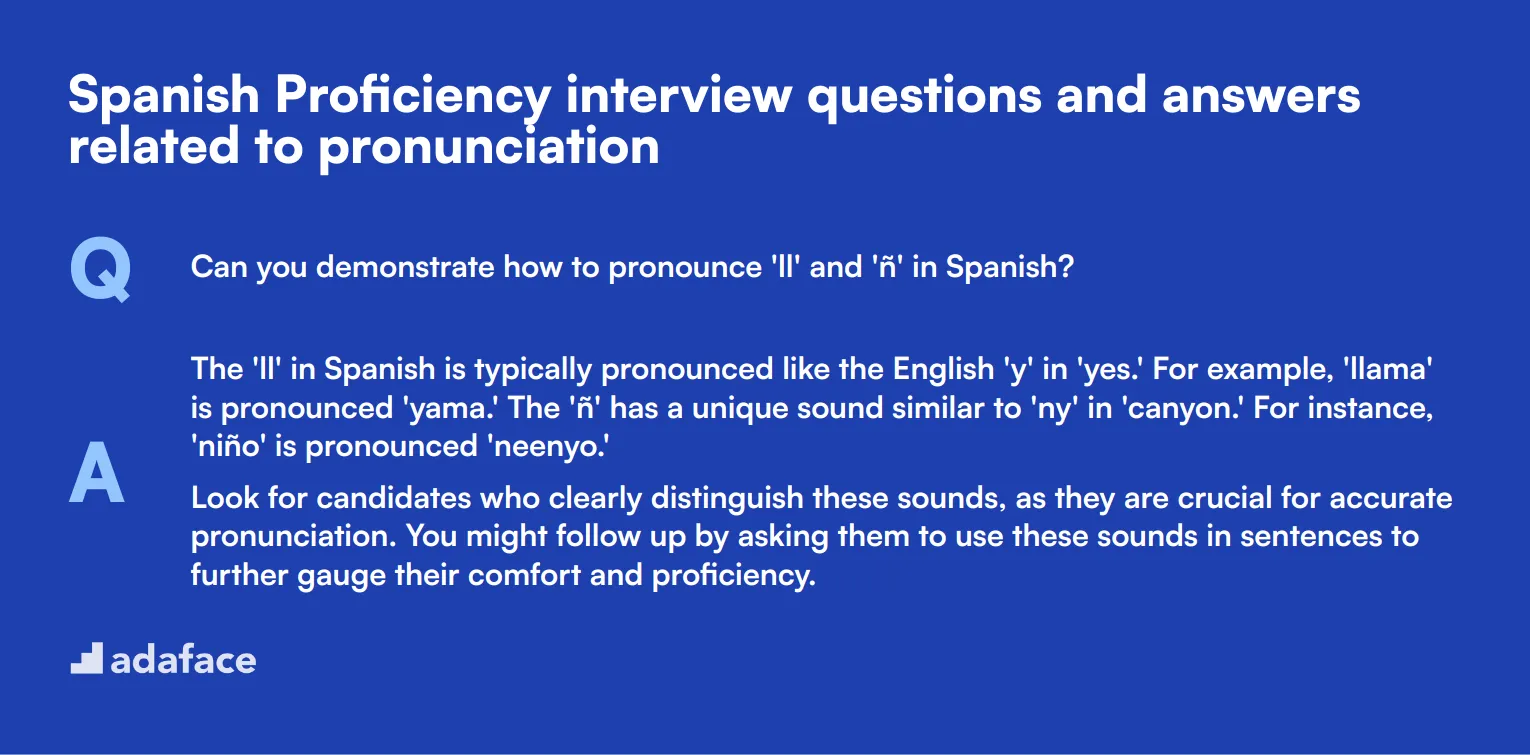
To ensure your candidates have a solid grasp of Spanish pronunciation, we’ve compiled a list of practical interview questions. Use these questions to assess their ability to pronounce words correctly and communicate clearly in Spanish, especially in professional settings.
1. Can you demonstrate how to pronounce 'll' and 'ñ' in Spanish?
The 'll' in Spanish is typically pronounced like the English 'y' in 'yes.' For example, 'llama' is pronounced 'yama.' The 'ñ' has a unique sound similar to 'ny' in 'canyon.' For instance, 'niño' is pronounced 'neenyo.'
Look for candidates who clearly distinguish these sounds, as they are crucial for accurate pronunciation. You might follow up by asking them to use these sounds in sentences to further gauge their comfort and proficiency.
2. How do you pronounce the Spanish vowels 'a,' 'e,' 'i,' 'o,' 'u'?
In Spanish, each vowel has a distinct sound: 'a' is pronounced like the 'a' in 'father,' 'e' is like the 'e' in 'bed,' 'i' is like the 'ee' in 'see,' 'o' is like the 'o' in 'more,' and 'u' is like the 'oo' in 'food.'
Candidates should demonstrate a clear understanding of these vowel sounds. An ideal response would include examples of words with these vowels. Consider asking for a short sentence using each vowel to check their fluency and natural pronunciation.
3. Can you explain the difference in pronunciation between 'b' and 'v' in Spanish?
In Spanish, 'b' and 'v' are pronounced very similarly, often leading to confusion for learners. Both are pronounced as a soft 'b' sound, somewhere between the English 'b' and 'v.' For example, 'vaca' (cow) and 'baca' (roof rack) are pronounced almost identically.
Look for candidates who understand this subtlety and can articulate the similarity. You might ask them to pronounce a few words with 'b' and 'v' to see if they can maintain the correct pronunciation consistently.
4. How do you pronounce the letter 'j' in Spanish words?
The letter 'j' in Spanish is pronounced like the English 'h,' but with more friction. For example, 'jugar' is pronounced 'hoogar.' This sound is produced at the back of the throat, similar to the 'ch' sound in the Scottish 'loch.'
Evaluate if the candidate can produce the correct guttural sound. If they struggle, ask them to pronounce a few words with 'j' to practice and ensure they can differentiate it from other similar sounds.
5. Can you explain and demonstrate the pronunciation of the Spanish 'r' and 'rr'?
The Spanish 'r' varies depending on its position in a word. A single 'r' at the beginning or between vowels is a tap, like in 'pero' (but), which is pronounced with a single flap of the tongue. The 'rr' is rolled, requiring multiple flaps, as in 'perro' (dog).
Strong candidates will distinguish clearly between the single tap 'r' and the rolled 'rr.' Ask them to use these sounds in sentences to see if they can maintain the distinction naturally in conversation.
6. How do you handle the pronunciation of 'c' and 'z' in Spanish, especially in Spain?
In Spain, the 'c' before 'e' or 'i' and 'z' are pronounced like the English 'th' in 'think,' known as the 'ceceo.' For example, 'cielo' (sky) is pronounced 'the-elo,' and 'zapato' (shoe) is pronounced 'tha-pa-to.' In Latin America, these letters are pronounced like an 's.'
Candidates should be aware of these regional differences. A good response will include examples and possibly a demonstration of both pronunciations to show their adaptability.
7. Can you pronounce a Spanish sentence with multiple syllables and explain any pronunciation rules you applied?
Sure, a sentence like 'El rápido zorro marrón salta sobre el perro perezoso' (The quick brown fox jumps over the lazy dog) incorporates various pronunciation rules. I applied the 'rr' roll in 'rápido' and 'marrón,' the soft 'r' in 'perro,' and the guttural 'j' in 'salta.'
Look for candidates who can articulate their thought process behind the pronunciation rules and demonstrate them accurately. This shows not only their pronunciation skills but also their understanding of underlying language rules.
9 situational Spanish Proficiency interview questions with answers for hiring top speakers

To make sure you're hiring top Spanish speakers, ask them some situational proficiency questions. These questions will help you gauge their practical language skills and how they handle real-world scenarios.
1. Can you describe a challenging work situation where you had to use Spanish to communicate effectively?
In my previous job, there was an instance where we had to negotiate a contract with a Spanish-speaking client. The client had specific needs and concerns, and it was my responsibility to address them clearly and concisely in Spanish.
I prepared by reviewing technical terms and relevant vocabulary beforehand, which helped me build confidence. During the meeting, I made sure to listen carefully, ask clarifying questions, and rephrase their concerns to ensure I understood them correctly.
An ideal candidate should demonstrate their ability to handle difficult conversations in Spanish, showing both their technical vocabulary and interpersonal skills. Look for examples of their problem-solving abilities and their methods of preparation.
2. How would you handle a situation where a Spanish-speaking colleague misunderstood an important task?
First, I would calmly and respectfully bring the misunderstanding to their attention, making sure to avoid any blame. I would then clarify the task details in Spanish, using simpler language if necessary, and provide written instructions to ensure there's no further confusion.
I might also ask them to repeat the task in their own words to confirm understanding. This step-by-step approach helps to ensure that everyone is on the same page and that the task gets completed correctly.
The ideal response should highlight the candidate's patience, ability to communicate clearly in Spanish, and their proactive approach to problem-solving. They should demonstrate empathy and effective strategies for ensuring clarity.
3. Describe a time when you had to translate a complex document from English to Spanish.
In a previous role as a technical writer, I was responsible for translating a detailed user manual for a new software product from English to Spanish. The document included complex technical terms and jargon that required precise translation to maintain the document's integrity.
I began by researching the appropriate technical terminology in Spanish and consulted with bilingual colleagues to ensure accuracy. I also used translation tools as a reference but relied primarily on my language skills to ensure the nuances were captured correctly.
Recruiters should look for candidates who mention thorough research and collaboration with others to achieve accurate translations. The ability to handle complex texts with attention to detail is crucial.
4. How do you approach conducting a training session in Spanish for new team members?
When conducting a training session in Spanish, I first prepare by creating training materials in Spanish, ensuring they are clear and easy to understand. I also practice my delivery to make sure I can explain concepts smoothly and answer any questions that might arise.
During the session, I use visual aids and interactive activities to engage the team members and facilitate learning. I encourage questions and make sure to provide practical examples that are relevant to the training topics.
An effective candidate should show their ability to prepare thoroughly and use various teaching techniques to ensure comprehension. They should demonstrate confidence in their Spanish-speaking skills and an understanding of how to engage their audience.
5. Can you describe how you would handle a disagreement with a Spanish-speaking colleague?
If I had a disagreement with a Spanish-speaking colleague, I would first seek to understand their perspective by listening carefully and asking open-ended questions in Spanish. This helps to show respect and ensures that I fully grasp their point of view.
I would then calmly explain my own perspective, using clear and respectful language. The goal would be to find common ground and work towards a mutually beneficial solution. If needed, I would suggest a follow-up meeting to keep the conversation focused and productive.
Candidates should demonstrate their ability to handle conflicts diplomatically and their proficiency in using Spanish to navigate sensitive situations. Look for examples of active listening, empathy, and problem-solving skills.
6. How would you write a follow-up email in Spanish after a meeting?
In a follow-up email after a meeting, I would start by thanking the participants for their time and summarizing the key points discussed. This would include any decisions made and action items assigned.
I would use clear and concise language, and make sure to include deadlines and next steps. For example, 'Gracias por su tiempo en la reunión de hoy. A continuación, resumo los puntos clave...' This ensures everyone is on the same page and knows what is expected going forward.
Look for candidates who demonstrate clarity and professionalism in their written Spanish communication. They should show an ability to succinctly summarize meetings and convey important information effectively.
7. Describe a recent project you worked on and your role in it, in Spanish.
Recientemente trabajé en un proyecto de lanzamiento de un nuevo producto en el mercado español. Mi papel principal fue el de gerente de marketing, encargado de desarrollar la estrategia de marketing y coordinar con los equipos de ventas y diseño.
Me aseguré de que todos los materiales promocionales estuvieran correctamente traducidos y adaptados al público español. También realicé varias presentaciones en español para clientes potenciales y participé en negociaciones clave.
Ideal answers should demonstrate the candidate's ability to clearly describe their responsibilities and contributions in Spanish. Look for fluency and the use of relevant industry-specific vocabulary.
8. How would you explain the basic structure of a formal Spanish business letter?
A formal Spanish business letter typically starts with the sender's address at the top right, followed by the date below it. The recipient's address is placed on the left. The salutation begins with 'Estimado/a' followed by the recipient's name.
The body of the letter should be clear and concise, divided into paragraphs. The closing typically includes a polite phrase such as 'Atentamente,' followed by the sender's name and position. For example, 'Atentamente, Juan Pérez, Gerente de Ventas.'
Candidates should show familiarity with the formal conventions of Spanish business communication. Look for structured answers that demonstrate their understanding of professional tone and format.
9. Can you tell me a story in Spanish about a memorable work experience?
Una experiencia laboral memorable fue cuando organizamos una conferencia internacional en Madrid. Fue un desafío coordinar a varios equipos de diferentes países, pero logramos que todo saliera a la perfección.
Durante la conferencia, tuve la oportunidad de presentar en español ante un gran público. Fue gratificante ver la buena acogida de nuestra presentación y recibir comentarios positivos de los asistentes.
Look for candidates who can narrate their experiences fluently and engagingly in Spanish. They should demonstrate a good command of past tense verbs and the ability to convey emotions and outcomes effectively.
10 Spanish Proficiency interview questions about cultural understanding
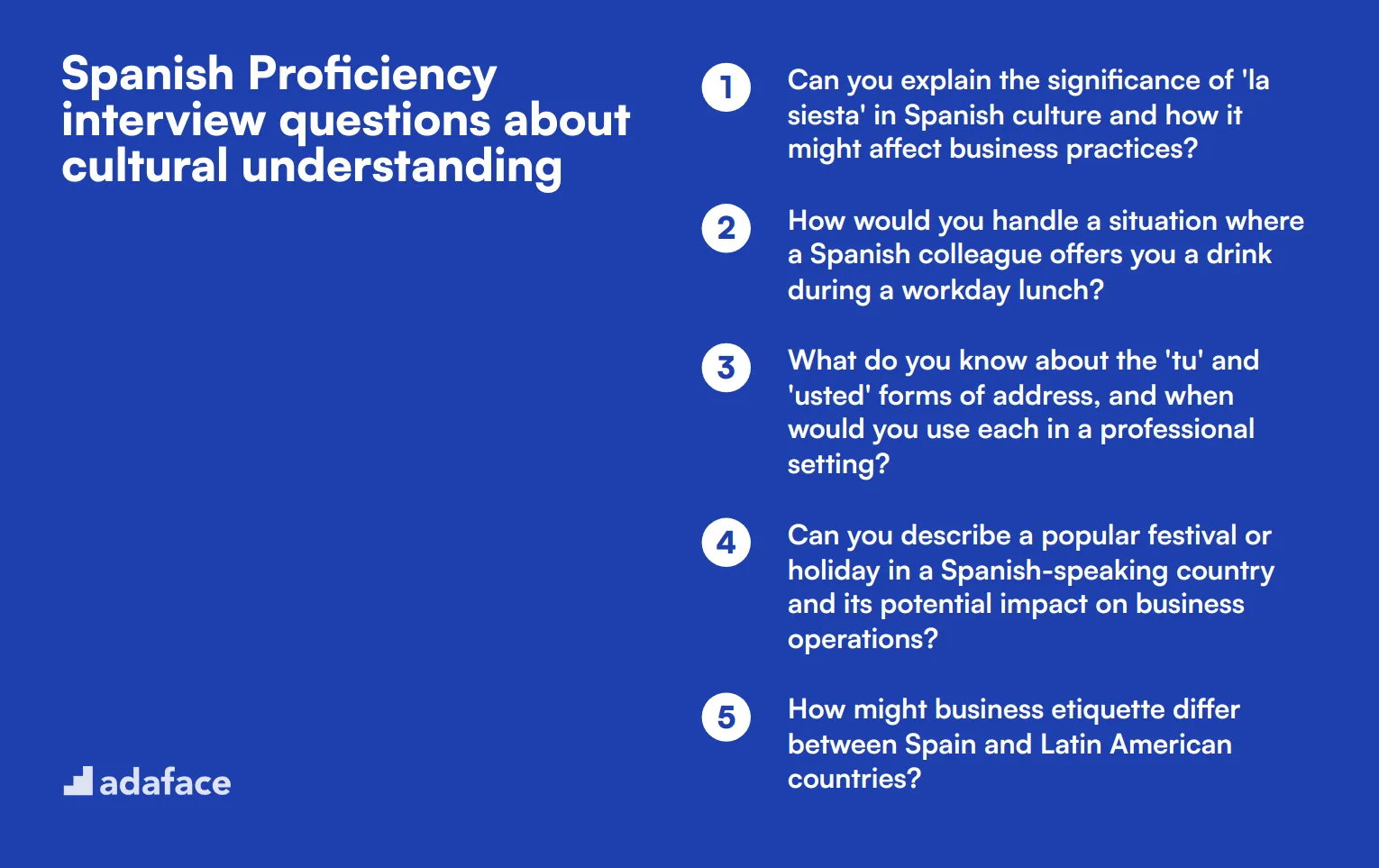
To assess candidates' cultural understanding of Spanish-speaking countries, use these 10 interview questions. These questions help evaluate applicants' knowledge of customs, traditions, and social norms, which is crucial for effective communication in Spanish-speaking environments.
- Can you explain the significance of 'la siesta' in Spanish culture and how it might affect business practices?
- How would you handle a situation where a Spanish colleague offers you a drink during a workday lunch?
- What do you know about the 'tu' and 'usted' forms of address, and when would you use each in a professional setting?
- Can you describe a popular festival or holiday in a Spanish-speaking country and its potential impact on business operations?
- How might business etiquette differ between Spain and Latin American countries?
- What are some common gestures or body language cues that have different meanings in Spanish-speaking cultures compared to English-speaking ones?
- How would you adapt your communication style when working with Spanish-speaking colleagues from different regions?
- Can you explain the concept of 'sobremesa' and its importance in Spanish business culture?
- What do you know about the role of family in Spanish-speaking cultures and how it might influence work-life balance?
- How would you approach gift-giving in a professional context with Spanish-speaking clients or partners?
Which Spanish Proficiency skills should you evaluate during the interview phase?
While it's impossible to assess every aspect of a candidate's Spanish proficiency in a single interview, focusing on key skills can provide valuable insights. The following core competencies are particularly important to evaluate during the Spanish Proficiency interview phase.
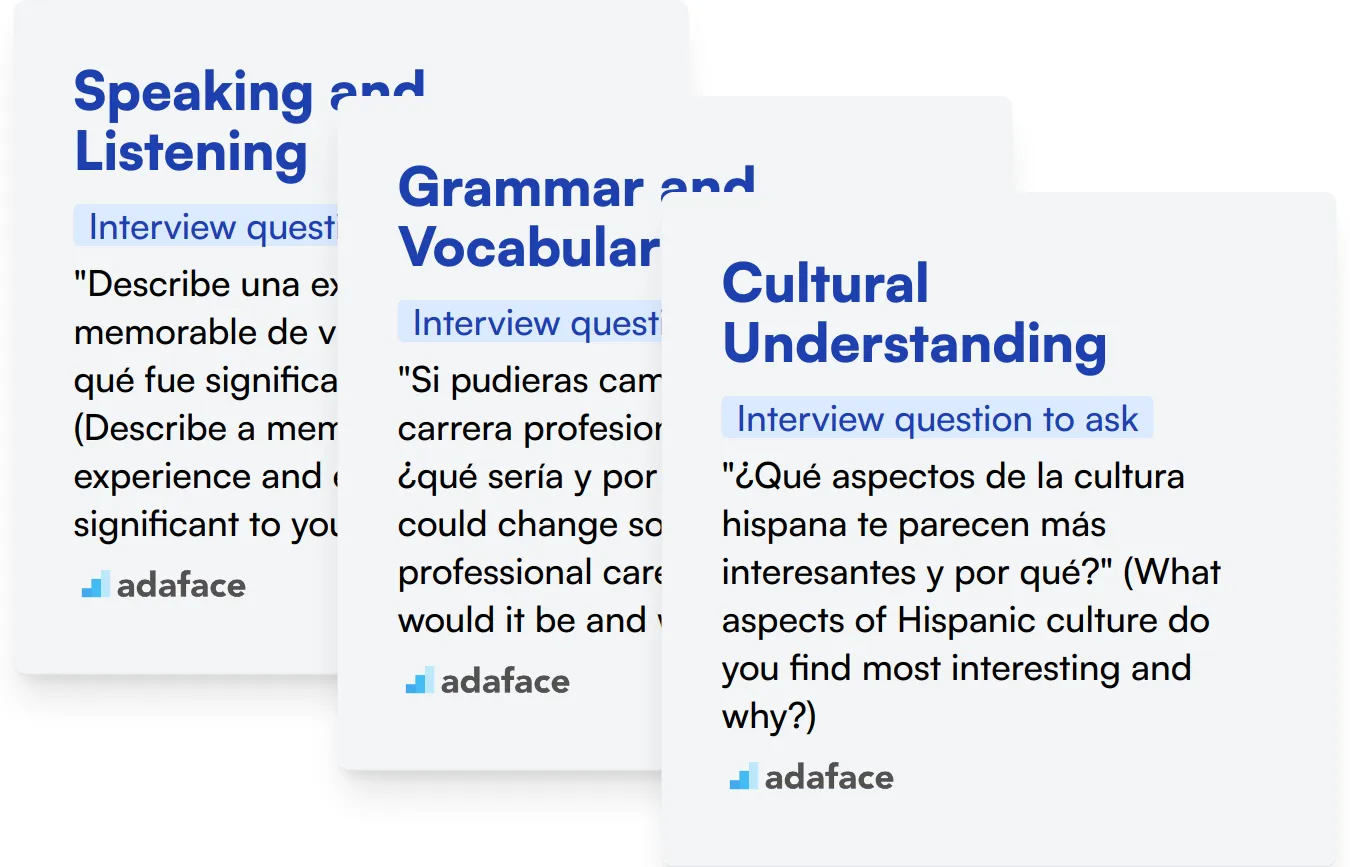
Speaking and Listening
Speaking and listening skills are fundamental for effective communication in Spanish. They demonstrate a candidate's ability to engage in real-time conversations and comprehend native speakers.
To assess these skills efficiently, consider using a Spanish proficiency test that includes listening comprehension and speaking components.
During the interview, you can evaluate these skills by asking open-ended questions that require detailed responses. Here's an example question:
"Describe una experiencia memorable de viaje y explica por qué fue significativa para ti." (Describe a memorable travel experience and explain why it was significant to you.)
Listen for fluency, pronunciation, vocabulary range, and the ability to construct coherent narratives. Pay attention to how well the candidate understands the question and responds appropriately.
Grammar and Vocabulary
A strong grasp of grammar and a rich vocabulary are essential for precise and nuanced communication in Spanish. These skills enable candidates to express complex ideas accurately.
Incorporate grammar and vocabulary sections in your assessment process to gauge the candidate's proficiency in these areas.
To evaluate grammar and vocabulary during the interview, consider asking a question that requires the use of various tenses and specific terminology. For example:
"Si pudieras cambiar algo en tu carrera profesional hasta ahora, ¿qué sería y por qué?" (If you could change something in your professional career so far, what would it be and why?)
Observe the candidate's use of conditional tenses, professional vocabulary, and overall sentence structure. Look for the ability to articulate hypothetical situations and reasoning clearly.
Cultural Understanding
Cultural understanding is key for effective communication in Spanish-speaking environments. It reflects a candidate's ability to navigate cultural nuances and appreciate context-specific communication styles.
To assess cultural understanding, ask a question that prompts the candidate to discuss cultural aspects of Spanish-speaking countries. Here's an example:
"¿Qué aspectos de la cultura hispana te parecen más interesantes y por qué?" (What aspects of Hispanic culture do you find most interesting and why?)
Look for awareness of cultural diversity within Spanish-speaking countries, understanding of cultural practices, and sensitivity to cultural differences. The response should demonstrate genuine interest and respect for Hispanic cultures.
3 Tips for Effectively Using Spanish Proficiency Interview Questions
As you prepare to implement what you have learned about Spanish proficiency interview questions, here are some final tips to enhance your interview process.
1. Incorporate Skills Assessments Before Interviews
Using skills tests before interviews can help you evaluate candidates' language abilities more objectively. By assessing their skills ahead of time, you gain insights into their proficiency level and can tailor your interview questions accordingly.
For evaluating Spanish proficiency, consider using tests like the Spanish Proficient C1 Test or the Spanish Upper Intermediate B2 Test. These assessments can effectively highlight candidates' strengths and weaknesses.
Implementing these tests in your hiring process allows you to focus on candidates who meet the desired proficiency level, which increases your chances of a successful hire. This leads us to the next important aspect of preparing for interviews.
2. Curate Targeted Interview Questions
With limited time during interviews, it's essential to select a focused set of questions that address key skills and competencies. This enables you to evaluate candidates efficiently while maximizing the insights you gather regarding their abilities.
Consider including relevant questions from other skill areas, such as communication or cultural understanding, as they can reveal additional dimensions of a candidate's fit for the role.
By narrowing down your question list to the most pertinent inquiries, you ensure a more effective evaluation of candidates across various important aspects.
3. Utilize Follow-Up Questions for Depth
Simply asking interview questions may not provide a complete picture of a candidate's proficiency or depth of understanding. Follow-up questions are necessary to uncover the nuances of a candidate's responses and ensure they possess the depth of knowledge required for the role.
For example, if a candidate says they are familiar with Spanish idioms, a good follow-up question could be, "Can you provide an example of an idiom you frequently use and its meaning?" This not only assesses their practical use of the language but also reveals their understanding of cultural context.
Use Spanish proficiency tests and interview questions to hire top Spanish speakers
Looking to hire someone with Spanish language skills? Make sure you assess their abilities accurately. The most effective way to do this is by using Spanish proficiency tests. Consider using our Spanish Proficient C1 Test or Spanish Upper Intermediate B2 Test to evaluate candidates' language skills.
After using these tests to shortlist the best applicants, you can invite them for interviews. To streamline your hiring process and find the most qualified Spanish speakers, explore our language tests or sign up to access our full range of assessment tools.
Spanish (Proficient/C1) test
Download Spanish Proficiency interview questions template in multiple formats
Spanish Proficiency Interview Questions FAQs
The questions cover various levels, including junior speakers, mid-tier speakers, and top speakers, allowing for a comprehensive assessment of Spanish language skills.
Use a mix of questions from different categories, adjust the difficulty based on the candidate's level, and pay attention to both accuracy and fluency in their responses.
Yes, cultural understanding questions help assess a candidate's familiarity with Spanish-speaking cultures, which is often crucial for effective communication.
It depends on the role requirements. For higher proficiency levels, conducting most of the interview in Spanish can provide a more accurate assessment of the candidate's skills.
Listen for proper stress, intonation, and pronunciation of specific sounds unique to Spanish. The pronunciation questions in this list can guide you in this assessment.

40 min skill tests.
No trick questions.
Accurate shortlisting.
We make it easy for you to find the best candidates in your pipeline with a 40 min skills test.
Try for freeRelated posts
Free resources




